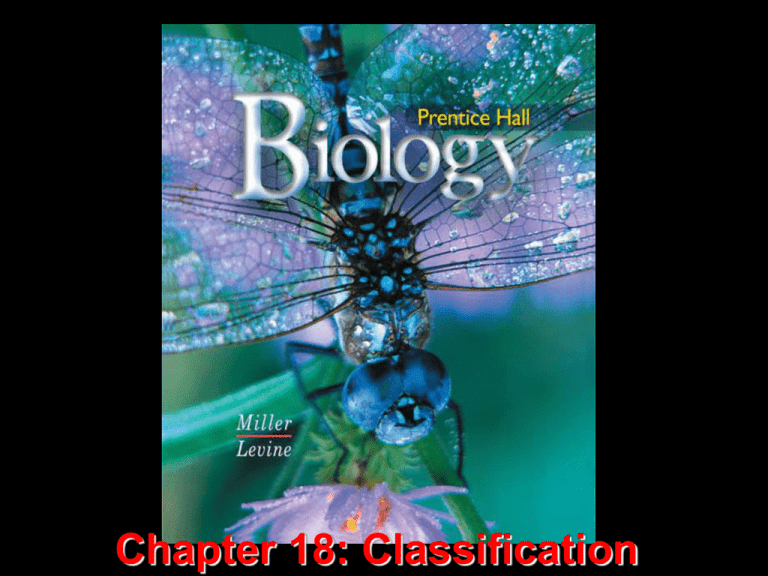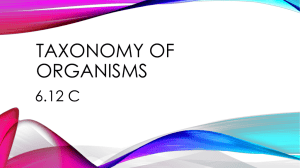ClassificationLoganBio
advertisement

Chapter 18: Classification 18-1 Finding Order in Diversity 18-1 Finding Order in Diversity Natural selection and other processes have led to a staggering diversity of organisms. Biologists have identified and named about 1.5 million species so far. They estimate that 2–100 million additional species have yet to be discovered. To study the diversity of life, biologists use a classification system to name organisms and group them in a logical manner. In the discipline of taxonomy, scientists classify organisms and assign each organism a universally accepted name. When taxonomists classify organisms, they organize them into groups that have biological significance. Assigning Scientific Names Common names of organisms vary, so scientists assign one name for each species. 18th century scientists understood Latin and Greek, so they used those languages for scientific names. This practice is still followed in naming new species. Early Efforts at Naming Organisms The first attempts at standard scientific names described the physical characteristics of a species in great detail. These names were not standardized because different scientists described different characteristics. Carolus Linneaus developed a naming system called binomial nomenclature. In binomial nomenclature, each species is assigned a two-part scientific name. The scientific name is italicized. The first part of the name is the Genus name (Capitalized). A Genus is a group of closely related species. The second part of the name is the species name (lowercase). The species name describes important trait or where the organism lives. Linnaeus's System of Classification Linnaeus not only named species, he also grouped them into categories. Linnaeus’s seven levels of classification are (from smallest to largest) species genus family order class phylum kingdom Each level is called a taxon, or taxonomic category. Species and genus are the two smallest categories. Grizzly bear Black bear Genera that share many characteristics are grouped in a larger category, the family. Grizzly bear Black bear FAMILY Ursidae Giant panda An order is a broad category composed of similar families. Grizzly bear Black bear Giant panda ORDER Carnivora Red fox The next larger category, the class, is composed of similar orders. Grizzly bear Black bear Giant panda CLASS Mammalia Red fox Abert squirrel Several different classes make up a phylum. Grizzly bear Black bear Giant panda PHYLUM Red fox Chordata Abert squirrel Coral snake The kingdom is the largest and most inclusive of Linnaeus's taxonomic categories. Grizzly bear Black bear Giant panda Red fox Abert squirrel KINGDOM Animalia Coral snake Sea star Grizzly Black Giant bear bear panda Coral Sea Red Abert fox squirrel snake star 18-2 Modern Evolutionary Classification Linnaeus grouped species into larger taxa mainly according to visible similarities and differences. Evolutionary Classification • Phylogeny is the study of evolutionary relationships among organisms. Biologists currently group organisms into categories that represent lines of evolutionary descent, or phylogeny, not just physical similarities. Grouping organisms based on evolutionary history is called evolutionary classification. The higher the level of the taxon, the further back in time is the common ancestor of the organisms in the taxon. Organisms that appear very similar may not share a recent common ancestor. • Different Methods of Classification Appendages Crab Conical Shells Barnacle Limpet Crustaceans Crab Barnacle Molted external skeleton Segmentation CLASSIFICATION BASED ON VISIBLE SIMILARITY Mollusks Limpet Tiny freeswimming larva CLADOGRAM Superficial similarities led barnacles and limpets to be grouped together. Appendages Crab Conical Shells Barnacle Limpet However, barnacles and crabs share an evolutionary ancestor that is more recent than the ancestor that barnacles and limpets share. Barnacles and crabs are classified as crustaceans, and limpets are mollusks. Many biologists now use a method called cladistic analysis • Cladistic analysis considers only new characteristics that arise as lineages evolve ( called derived characters). • Characteristics that appear in recent parts of a lineage but not in its older members are called derived characters. Derived characters can be used to construct a cladogram, a diagram that shows the evolutionary relationships among a group of organisms. Cladograms help scientists understand how one lineage branched from another in the course of evolution. A cladogram shows the evolutionary relationships between crabs, barnacles, and limpets. Crustaceans Crab Mollusk Barnacle Limpet Molted external skeleton Segmentation Free-swimming larva The genes of many organisms show important similarities at the molecular level. Similarities in DNA can be used to help determine classification and evolutionary relationships. DNA Evidence • DNA evidence shows evolutionary relationships of species. • The more similar the DNA of two species, the more recently they shared a common ancestor, and the more closely they are related in evolutionary terms. • The more two species have diverged from each other, the less similar their DNA is. Molecular Clocks • Comparisons of DNA are used to mark the passage of evolutionary time. • A molecular clock uses DNA comparisons to estimate the length of time that two species have been evolving independently. Molecular Clocks A gene in an ancestral species 2 mutations new mutation Species A 2 mutations new new mutation mutation Species B Species C A molecular clock relies on mutations to mark time. Simple mutations in DNA structure occur often. Neutral mutations accumulate in different species at about the same rate. Comparing sequences in two species shows how dissimilar the genes are, and shows when they shared a common ancestor. 18-3 Kingdoms and Domains The Tree of Life Evolves • Systems of classification adapt to new discoveries. • Linnaeus classified organisms into two kingdoms—animals and plants. • Only known differences among living things were the fundamental traits that separated animals from plants. There are enough differences among organisms to make 5 kingdoms: Monera Protista Fungi Plantae Animalia Six Kingdoms • Recently, biologists recognized that Monera were composed of two distinct groups: • Eubacteria and Archaebacteria. The six-kingdom system of classification includes: • Eubacteria • Archaebacteria • Protista • Fungi • Plantae • Animalia Changing Number of Kingdoms Names of Kingdoms Introduced 1700’s Late 1800’s 1950’s 1990’s Plantae Plantae Protista Monera Eubacteria Archaebacteria Animalia Animalia Protista Fungi Plantae Animalia Protista Fungi Plantae Animalia Six Kingdoms Bacteria Archaea Eubacteria Archaebacteria Prokaryote Prokaryote E.coli halophiles Eukarya Protista Fungi Plantae Animalia Eukaryote Amoeba Mushroom, yeast Moss, ferns, flowering plants Sponges, worms, insects, fishes, mammals The Three-Domain System • Molecular analyses have given rise to the three-domain system of taxonomy now recognized by many scientists. • The domain is a more inclusive category than any other—larger than a kingdom. The three domains are: • Eukarya, which is composed of protists, fungi, plants, and animals. • Bacteria, which corresponds to the kingdom Eubacteria (true bacteria). • Archaea, which corresponds to the kingdom Archaebacteria. Modern classification is a rapidly changing science. As new information is gained about organisms in the domains Bacteria and Archaea, they may be subdivided into additional kingdoms. Domain Bacteria Domain Bacteria • Members of the domain Bacteria are unicellular prokaryotes. • Their cells have thick, rigid cell walls that surround a cell membrane. • Their cell walls contain peptidoglycan. Domain Bacteria The domain Bacteria corresponds to the kingdom Eubacteria. Domain Archaea Domain Archaea • Members of the domain Archaea are unicellular prokaryotes. • Archaea live in extreme environments. • Their cell walls lack peptidoglycan, and their cell membranes contain unusual lipids not found in any other organism. Domain Archaea The domain Archaea corresponds to the kingdom Archaebacteria. Domain Eukarya •The domain Eukarya consists of organisms that have a nucleus. •Eukarya includes the kingdoms: Protista Fungi Plantae Animalia Domain Eukarya Domain Eukarya Protista • The kingdom Protista is composed of eukaryotic organisms that cannot be classified as animals, plants, or fungi. • Its members display the greatest variety. • They can be unicellular or multicellular; photosynthetic or heterotrophic; and can share characteristics with plants, fungi, or animals. Domain Eukarya Fungi • Members of the kingdom Fungi are heterotrophs with cell walls of chitin. • Most fungi feed on dead or decaying organic matter by secreting digestive enzymes into it and absorbing small food molecules into their bodies. • They can be either multicellular (mushrooms) or unicellular (yeasts). Domain Eukarya Plantae • Members of the kingdom Plantae are multicellular, photosynthetic autotrophs. • Plants are nonmotile—they cannot move from place to place. • Plants have cell walls of cellulose. • The plant kingdom includes cone-bearing and flowering plants, mosses and ferns. Domain Eukarya Animalia • Members of the kingdom Animalia are multicellular and heterotrophic. • Cells of animals do not have cell walls. • Most animals can move about. • There is great diversity within the animal kingdom, and many species exist in nearly every part of the planet. Which statement about classification is true? a. Biologists use regional names for organisms. b. Biologists use a common classification system based on similarities that have scientific significance. c. Biologists have identified and named most species found on Earth d. Taxonomy uses a combination of common and scientific names to make the system more useful. Linnaeus's two-word naming system is called a. binomial nomenclature. b. taxonomy. c. trinomial nomenclature. d. classification. Several different classes make up a(an) a. family. b. species. c. kingdom. d. phylum. A group of closely related species is a(an) a. class. b. genus. c. family. d. order. Which of the following lists the terms in order from the group with the most species to the group with the least? a. order, phylum, family, genus b. family, genus, order, phylum c. phylum, class, order, family d. genus, family, order, phylum Grouping organisms together based on their evolutionary history is called a. evolutionary classification. b. traditional classification. c. cladogram classification. d. taxonomic classification. Traditional classification groups organisms together based on a. derived characters. b. similarities in appearance. c. DNA and RNA similarities. d. molecular clocks. In an evolutionary classification system, the higher the taxon level, a. the more similar the members of the taxon become. b. the more common ancestors would be found in recent time. c. the fewer the number of species in the taxon. d. the farther back in time the common ancestors would be. Classifying organisms using a cladogram depends on identifying a. external and internal structural similarities. b. new characteristics that have appeared most recently as lineages evolve. c. characteristics that have been present in the group for the longest time. d. individual variations within the group. To compare traits of very different organisms, you would use a. anatomical similarities. b. anatomical differences. c. DNA and RNA. d. proteins and carbohydrates. Organisms whose cell walls contain peptidoglycan belong in the kingdom a. Fungi. b. Eubacteria. c. Plantae. d. Archaebacteria. Multicellular organisms with no cell walls or chloroplasts are members of the kingdom a. Animalia. b. Protista. c. Plantae. d. Fungi. Organisms that have cell walls containing cellulose are found in a. Eubacteria and Plantae. b. Fungi and Plantae. c. Plantae and Protista. d. Plantae only. Molecular analyses have given rise to a new taxonomic classification that includes a. three domains. b. seven kingdoms. c. two domains. d. five kingdoms. Which of the following contain more than one kingdom? a. only Archaea b. only Bacteria c. only Eukarya d. both Eukarya and Archaea










